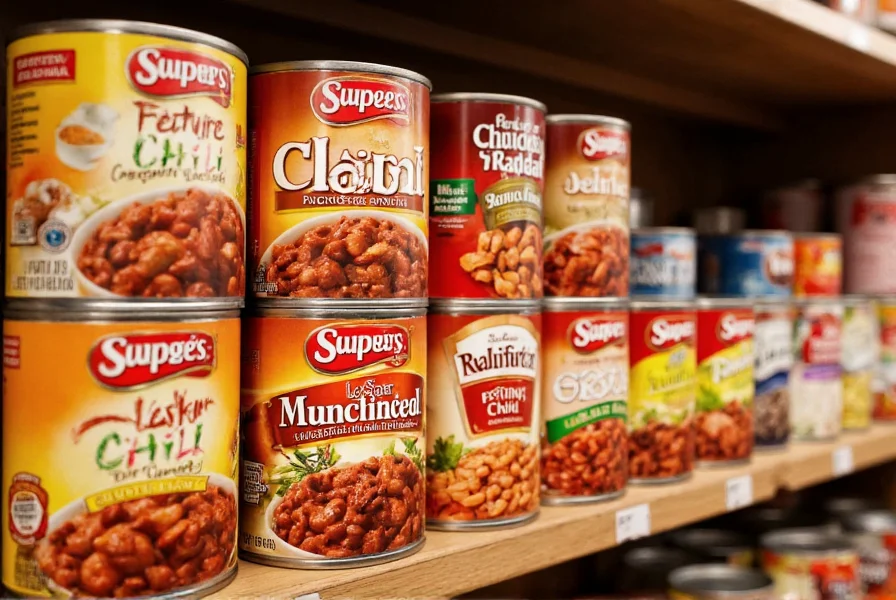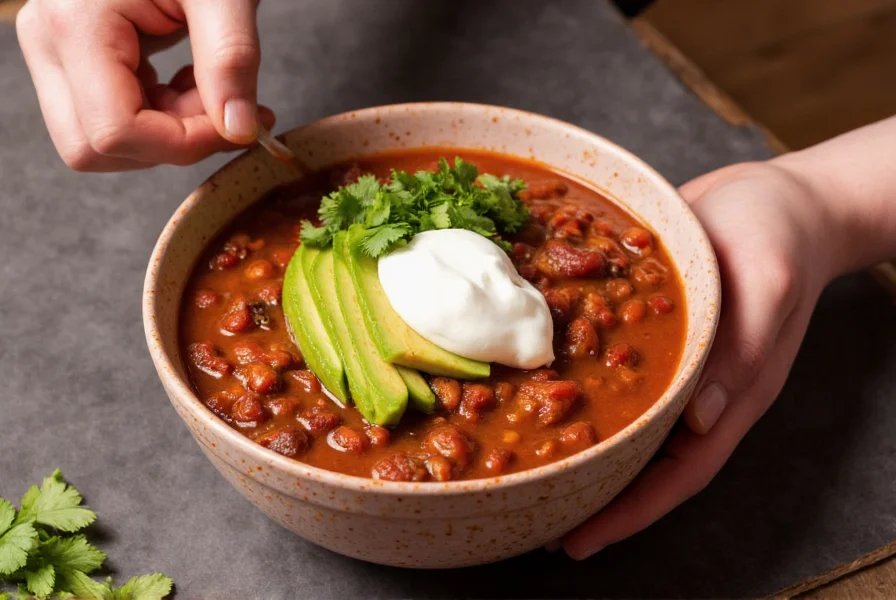Understanding Canned Chili: More Than Just Convenience
When you open a can of chili, you're accessing a complete meal solution that's been perfected for shelf stability and flavor retention. Most commercial chili varieties contain a base of tomatoes, onions, garlic, and chili peppers, combined with either ground beef or vegetarian alternatives. The canning process locks in nutrients while creating a product with remarkable versatility in the kitchen.
Key Components of Quality Canned Chili
Not all chili cans deliver equal quality. Understanding what goes into your can helps make informed choices:
| Ingredient Category | Quality Indicators | What to Avoid |
|---|---|---|
| Protein Source | Clearly labeled meat type (e.g., "90% lean ground beef") | Vague terms like "meat by-products" |
| Beans | Whole beans without mushiness | Excessive bean breakdown or disintegration |
| Tomato Base | Natural tomato flavor without artificial aftertaste | Overly sweet or metallic flavors |
| Spices | Balanced heat with discernible chili pepper varieties | Overpowering artificial spice flavors |
Nutritional Profile of Canned Chili
Canned chili offers substantial nutrition when selected wisely. A typical serving (about 1 cup) provides:
- Protein: 12-18g (supports muscle maintenance)
- Fiber: 6-9g (from beans and vegetables)
- Vitamins: Significant vitamin C from tomatoes, B vitamins from meat
- Minerals: Iron, zinc, and potassium content varies by recipe
Watch for sodium content, which can range from 400-1000mg per serving. Many brands now offer low-sodium canned chili options that maintain flavor through enhanced spice blends rather than salt.
Selecting the Best Canned Chili
When choosing the best canned chili for quick meals, consider these factors:
Reading Labels Effectively
Look beyond marketing claims to examine the actual ingredient list. High-quality products typically have shorter ingredient lists with recognizable components. Avoid products with excessive preservatives or artificial flavors.
Dietary Considerations
For vegetarian canned chili options, check that the product uses vegetable broth instead of meat-based stocks. Gluten-free seekers should verify that thickening agents don't contain wheat derivatives.

Creative Ways to Use Canned Chili
Transform your can of chili from basic to brilliant with these techniques:
Elevating Flavor Profiles
Professional chefs often enhance canned chili with:
- A splash of craft beer or red wine for depth
- Freshly squeezed lime juice to brighten flavors
- Smoked paprika or chipotle peppers for complexity
- High-quality chocolate (70% cacao) for richness
Recipe Transformations
Don't just heat and serve—try these creative ways to enhance canned chili:
- Chili Mac: Combine with cooked elbow pasta and top with cheddar
- Stuffed Sweet Potatoes: Bake sweet potatoes and fill with warmed chili
- Chili Cornbread Casserole: Layer with cornbread batter and bake
- Chili Tacos: Use as taco filling with avocado and cilantro

Storage Guidelines and Shelf Life
Proper storage maximizes both safety and quality of your canned chili shelf life:
Unopened Cans
Store in a cool, dry place away from direct sunlight. Most canned chili maintains best quality for 2-3 years, though it remains safe beyond this if the can shows no damage. Check for:
- Rust spots (small surface rust is usually fine, but extensive rust requires discard)
- Dents (avoid cans with deep dents, especially near seams)
- Bulging (immediately discard bulging cans as they may contain botulism)
After Opening
Transfer unused portions to an airtight container and refrigerate. Consume within 3-4 days for best quality. For longer storage, freeze portions in labeled containers for up to 3 months.
Safety Considerations
While commercially canned chili undergoes rigorous safety processes, proper handling remains essential:
- Never consume from cans showing signs of spoilage (bulging, leaking, or foul odors)
- Always heat canned chili to 165°F (74°C) before serving
- Discard any chili that develops mold or off-odors during storage
- When in doubt about how to tell if canned chili has gone bad, follow the rule: "When unsure, throw it out"
Canned vs. Homemade: Making the Right Choice
While homemade vs canned chili comparisons often favor homemade for flavor control, canned versions offer distinct advantages:
- Time savings: Ready in minutes versus hours for homemade
- Consistency: Uniform flavor batch to batch
- Nutrient retention: Modern canning preserves nutrients effectively
- Cost efficiency: Often more economical than sourcing individual ingredients
Consider using canned chili as a base that you enhance with fresh ingredients—a perfect middle ground between convenience and customization.
Frequently Asked Questions
Can you freeze canned chili after opening?
Yes, transfer opened canned chili to an airtight container or freezer bag, removing as much air as possible. Properly frozen, it maintains quality for 2-3 months. Thaw overnight in the refrigerator before reheating to 165°F (74°C).
How can I reduce the sodium in canned chili?
Choose low-sodium varieties when available, or rinse the chili through a fine-mesh strainer under cold water for 30 seconds to remove up to 40% of surface sodium. Enhance flavor with additional spices, citrus juice, or vinegar rather than adding salt.
What's the difference between chili with beans and chili without beans?
Chili without beans (often called "Texas-style") focuses on meat and tomato base with richer, more concentrated flavors. Chili with beans provides additional fiber and creates a heartier, more filling meal. Both styles are authentic—bean inclusion depends on regional preferences and personal taste.
Can I use canned chili in a slow cooker recipe?
Absolutely. Canned chili works well as a base in slow cooker recipes. Add fresh ingredients like diced vegetables, additional spices, or protein sources, then cook on low for 2-3 hours to blend flavors without overcooking the existing components.











 浙公网安备
33010002000092号
浙公网安备
33010002000092号 浙B2-20120091-4
浙B2-20120091-4